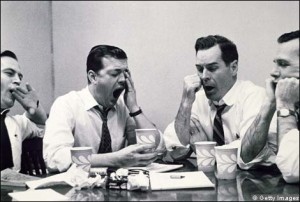YAWNING
V. Gating the Yawn
A. Regions open to modulation
1. Nucleus of the Solitary Tract
a. Series of medullary nuclei regulating autonomic
and respiratory function
b. upstream of NST
i. PVN
ii. Apneustic Center
iii. carotid bodies, aortic bodies, lungs & pharynx
stretch receptors
c. downstream of NST
i. SCG
ii. reticular formation, hypothalamus, thalamus
1) feedback
2. PVN
a. hypothalamic nucleus regulating stress responses, autonomic function,
and appetite
i. electrical stimulation of PVN Þñ Yawning
b. secretes CRF, GABA, OT, AVP, TRH
c. upstream of PVN
i. SCN
1) biological clock
ii. CeA
d. downstream of PVN
i. brainstem (NST), spinal cord, hypothalamus,
limbic brain
2. SCN
a. central oscillator - keeps time for other oscillatory nuclei
b. secretes AVP, GABA, Glu, VIP,
cardiotriphin-like cytokine, prokinectin 2
c. upstream of SCN
i. retinal ganglion cells, intergeniculate Leaflet (IGL)
of the Thalamic Lateral Geniculate Nucleus
ii. median raphé
1) secretes serotonin
(5-HT, 5-hydroxytryptamine)
3. CeA
a. mediates fear, stress, and anxiety output of the amydgala
i. amygdala is a cluster of nuclei
b. regulates sympathetic autonomic function
c. secretes CRF and GABA
d. upstream of the CeA
i. hippocampus
ii. prefrontal cortex (PFC)
B. Circadian Gating
1. modifying the timing or frequency of yawning through phase of SCN
activity = entrainment
a. D sensory or neurochemical input to SCN
i. early night light ÞñGlu Þ SCN Þ phase delay
1) later initiation of sleep, later waking
2) late night light ÞñGlu Þ SCN NMDAÞ
Þñ SCN NMDAÞ phase advance
ii. 5-HT
1) raphé Þ SCN
2) 5-HTÞñSCN 5-HT7 receptors Þ phase delay
b. D clock output Þ D sleep/wake timing
2. SCN output modifies PVN activity
a. CoreSCN ó ShellSCN Þ AVP Þñ PVN V1A receptors Þñ firing
b. possibly:Day/Night transitions Þñ SCN FiringÞ AVP Þñ PVN firing
3. PVN regulates autonomic sympathetic function
a. Þñ PVN firing Þñ sympathetic output
4. sympathetic activity stimulates yawning
a. stimulation of the PVN Þñ yawning
D. Limbic Gating
1. modifying the likelihood of yawning through emotion
a. e.g. anxiety Þñ yawning
i. just prior to: parachuting, taking a test, a race...
2. emotional inputs to the yawning circuitry
a. inputs from CeA, hippocampus, PFC
3. stimulated by spatial and social cues to anxiety
a. e.g. skydiving plane or test room
i. activate hippocampal circuits
1) hippocampus modulates spatial memories
and spatial relationships
2) temporal and organizational memories
spatio-temporal relationships
a) yikes! it's a long way to the ground
I will be falling a long time
4. stimulated by fearful anticipation of the activity
a. activate amygdalar neurons in the CeA
b. memory of fear activate neurons in the BLA
i. basolateral amygdala connects to CeA
c. ñ CeA activity Þñ PVN activity
5. electrical stimulation/histamine Þ PVN Þñ Yawning
E. PVN-NST-Sympathetic Convergence
1. Yawning is caused by a transient ñ sympathetic arousal
a. multiple paths to sympathetic activation
2. Circadian and Emotional pathways converge on the PVN
a. stimulation of the PVN Þñ yawning
3. PVN directly activates authonomic function in the NST
a. NST pathways trigger 3 elements important to yawning
i. sympathetic activation
ii. muscles of pharynx
1) initial step in the 1st phase of yawning
iii. muscles of inspiration
F. Integration of Gating
1. transition of arousal states
2. circadian rhythms are influenced strongly by emotional status
a. Þñ stress Þñ 5-HT release
1) in Hippocampus, Amygdala, PFC, and SCN
a) SCN ÞñAVP ÞñPVN
3. emotional states are influenced by circadian regulation
of behavior and physiology
a. classic symptoms of depression:
i. phase delayed circadian rhythms
ii. reduced PVN and Hippocampal feedback
responsiveness to stress hormones
b. SCN ÞñAVP ÞñPVN
c. SCN core Þ IGL Þ d & m raphé Þñ 5-HT
in PVN, Hippocampus and Amygdala
VI. Norepinephrine (NE)
VII. Oxytocin (OT)
VIII. ACTH & aMSH
